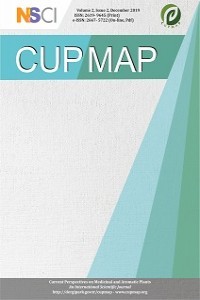Tea Tree Oil and Its Use in Aromatherapy
Tea Tree Oil and Its Use in Aromatherapy
Aromatherapy, Melaleuca alternifolia, TTO Tea tree, phytotherapy,
___
- REFERENCES:
- -Ali, B., Al-Wabel, N.A., Shams, S., Ahamad, A., Khan, S.A., Anwar, F., 2015. Essential oils used in aromatherapy: A systemic review. Asian Pacific Journal of Tropical Biomedicine, 5 (8), 601-611.
- -Giacinto, B., Cosentino, M., Sakurada, T., 2016. Aromatherapy: Basic Mechanisms and Evidence Based Clinical Use 2015, CRC Press, Taylor & Francis Group, Boca Raton London New York, 174.
- -Bishop, C.D., 1995. Antiviral activity of the essential oil of Melaleuca alternifolia. (Maiden and Betche) Cheel (Tea Tree) Against Tobacco Mosaic Virus. Journal of Essential Oil Research, 7(6), 641-644.
- -Brady, A., Loughlin, R., Gilpin, D., Kearney, P., Tunney, M., 2006. In vitro activity of tea-tree oil against clinical skin isolates of meticillin-resistant and-sensitive Staphylococcus aureus and coagulase-negative staphylococci growing planktonically and as biofilms. Journal of Medical Microbiology, 55 (10), 1375-1380.
- -Buckle, J. 2016. Clinical Aromatherapy. Essential oils in healthcare. Third edition, 432, Elsevier, Pages London, UK, 20-21.
- -Carson, C.F., Hammer, K.A., Riley, T.V., 2006. Melaleuca alternifolia (Tea Tree Oil): A Review of Antimicrobial and Other Medicinal Properties. Clinical Microbiology Reviews, 19 (1), 50-62.
- -Carson, C.F., Mee, B.J., Riley, T.V., 2002. Mechanism of Action of Melaleuca alternifolia (Tea Tree) Oil on Staphylococcus aureus Determined by Time-Kill, Lysis, Leakage, and Salt Tolerance Assays and Electron Microscopy. Antimicrobial Agents and Chemotherapy, 46 (6), 1914-1920.
- -Carson, C.F., Riley, T.V., 1993. Antimicrobial activity of the essential oil of Melaleuca alternifolia. Journal of Applied Microbiology, 16(2), 49-55.
- -Carson, C.F., Riley, T.V., 2001. Safety, efficacy and provenance of tea tree (Melaleuca alternifolia) oil. Contact Dermatitis environmental and occupational dermatitis, 45 (2), 65-67.
- -Cox, S.D., Mann, C.M., Markham, J.L., Bell, H.C., Gustafson, J.E., Warmington, J.R., Wyllie, S.G., 2000. The mode of antimicrobial action of the essential oil of Melaleuca alternifolia (tea tree oil), Journal of Applied Microbiology, 88 (1), 170-175.
- -Çakır, N.T., Kaleağasi, S., Kökdil, G., 2005. Tea tree oil: As a promising antimicrobial agent: Tea Tree Oil. J. Fac. Pharm Ankara, 34 (4), 315 - 327.
- -Edris, A.E., 2007. Pharmaceutical and therapeutic potentials of essential oils and their individual essential constituents: a review. Phytotherapy Research, 21(4), 308-323.
- -Gupta, P.D., Birdi, T.J., 2017. Development of botanicals to combat antibiotic resistance. The Foundation for Medical Research, 84-A, R.G. Thadani Marg, Worli, Mumbai, 400 018, Maharashtra, India. Journal of Ayurveda and İntegrative Medicine, 8(4), 266-275.
- -Hammer, K.A., Carson, C.F., Riley, T.V., 2012. Effects of Melaleuca alternifolia (Tea Tree) Essential Oil and the Major Monoterpene Component Terpinen-4-ol on the Development of Single-and Multistep Antibiotic Resistance and Antimicrobial Susceptibility. Antimicrobial Agents and Chemotherapy, 56(2), 909–915.
- -Hammer, K.A., 2014. Review Treatment of acne with tea tree oil (melaleuca) products: A review of efficacy, tolerability and potential modes of action. Journal Of Antimicrobial Agents, 45(2), 106-110.
- -Herz, R.S., 2009. Aromatherapy Facts and Fictions: A Scientific Analysis of Olfactory Effects on Mood, Physiology and Behavior. International Journal of Neuroscience, 119(2), 263-90.
- -Lam, N. S. K., Long, X. X., Griffin, R. C., Chen, M.K., Doery, James C.G., 2018. Can the tea tree oil (Australian native plant: Melaleuca alternifolia Cheel) be an alternative treatment for human demodicosis on skin? Parasitology, 145 (12), 1510-1520.
- -Mertas, A., Garbusinska, A., Szliszka, E., Jureczko, A., Kowalska, M., Król, W., 2015. The Influence of Tea Tree Oil (Melaleuca alternifolia) on Fluconazole Activity against Fluconazole-Resistant Candida albicans Strains. BioMed Research International, 2015, Article ID 590470, 9.
- -Mikus, J. A.Q., Michae, H., Dietmar, S., Jürgen, R., 2000. In vitro Effect of Essential Oils and Isolated Mono- and Sesquiterpenes on Leishmania major and Trypanosoma brucei. Planta Medica, 66(4), 366-8.
- -Mumu, S.K., Hossain, M.M., 2018. Antimicrobial Activity of Tea Tree oil against Pathogenic Bacteria and Comparison of Its Effectiveness with Eucalyptus Oil, Lemongrass Oil and Conventional Antibiotics. American Journal of Microbiological Research, Volume 6(3), 73-78.
- -Pazyar, N., Reza, Y., Nooshin, B., and Afshin K., 2013. A review of applications of tea tree oil in dermatology. International Journal of Dermatology, 52(7), 784-790.
- -Rehman, R., Hanif, M.A., Mushtaq, Z., 2016. Biosynthetic Factories of Essential Oils: The Aromatic Plants Article• Journal Food Reviews International, 32(2), 117-160.
- -Sabir, S., Zahara, K., Tabassum, S., 2014. Pharmacological attributes and nutritional benefits of tea tree oil International. Journal of Biosciences, 5(2), 80-91.
- -Sharifi, J.R., Salehi, B., Varoni, E.M., Sharopov, F., Yousaf, Z., Ayatollahi, S.A., Kobarfard, F., Mehdi, S. R., Afdjei, M. H., Majid, S.R., and Iriti, M., 2017. Plants of the Melaleuca Genus as Antimicrobial Agents: From Farm to Pharmacy. Phytotherapy Research, 31(10), 1475-1494.
- -Shibamoto, K., Mochizuki, M., Kusuhara, M., 2010. Aromatherapy in Anti-Aging Medicine. Japanese Society of Anti-Aging Medicine, 7(6), 55-59.
- -Zhang, X., Guo, Y., Guo, L., Jiang, H., and Ji Q., 2018. In Vitro Evaluation of Antioxidant and Antimicrobial Activities of Melaleuca alternifolia Essential Oil. BioMed Research International, 2018, Article ID 2396109, 8 pages.
- -SCCP- 2008
- -http://www.theplantlist.org/browse/A/Myrtaceae/Melaleuca/
- ISSN: 2619-9645
- Yayın Aralığı: Yılda 2 Sayı
- Başlangıç: 2018
- Yayıncı: Nazım ŞEKEROĞLU
Gökhan CENGİZ, Evren ALGIN YAPAR
Volatile and Phenolic Compositions of the Leaves of Two Vinca L. Species from Turkey
Ela Nur ŞİMŞEK SEZER, Tuna UYSAL
Detection and Quantification of Preservatives in Green Cosmetics
Evren ALGIN YAPAR, Nilay CİVİL, Ebru ÜNCÜOĞLU
Tea Tree Oil and Its Use in Aromatherapy
Ufuk ÇALIŞKAN, Müjgan ÖZFENERCİ
Studies on Natural Cosmetic R & D – From Laboratory to Prototype Product
İlkay ERDOĞAN ORHAN, Fatma Sezer ŞENOL DENİZ
International Standards of Microbiological Quality in Cosmetic Products
Evren ALGIN YAPAR, Gökhan CENGİZ
The Potential of Marine Resources in Cosmetics
Levent ALPARSLAN, Nazım ŞEKEROĞLU, Anake KIJJOA
Microbiological Property Evaluation of Natural Essential Oils Used in Green Cosmetic Industry
Ecem ÖZDEMİR, İsmail ASLAN, Bekir ÇAKICI, Betül TÜRKER, Cem Emre ÇELİK
